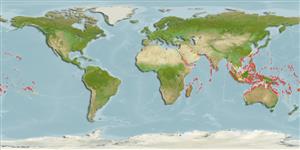Environment: milieu / climate zone / depth range / distribution range
Écologie
marin récifal; profondeur 0 - 23 m (Ref. 58302), usually 1 - 3 m (Ref. 58302). Tropical; 30°N - 33°S, 26°E - 124°W
Indo-Pacific: Red Sea and East Africa (Ref. 5470) to the Marquesan Islands and Mangaréva, north to southern Japan and the Hawaiian Islands, south to the Kermadec and Rapa Islands.
Taille / Poids / Âge
Maturity: Lm ? range ? - ? cm
Max length : 30.0 cm TL mâle / non sexé; (Ref. 9947); common length : 23.0 cm TL mâle / non sexé; (Ref. 9947)
Épines dorsales (Total): 10; Rayons mous dorsaux (Total): 11; Épines anales 3; Rayons mous anaux: 6. Light brown, whitish below, with white and dark brown spots (Ref. 5469).
Inhabits reef fronts and rocky shorelines exposed to moderate to strong surge to depths of about 3 m (Ref. 9947). Benthic (Ref. 58302). Feeds primarily on crabs, also takes other crustaceans, small fishes, sea urchins or brittle stars. Marketed fresh (Ref. 9947).
Life cycle and mating behavior
Maturité | Reproduction | Frai | Œufs | Fécondité | Larves
Pelagic spawner (Ref. 31569). Spawning ascents into the water column occurred over a distance of 1.5 to 2.0 m (Ref. 26305). Further histological evidence is needed to establish protogyny (Ref. 103751).
Randall, J.E., G.R. Allen and R.C. Steene, 1990. Fishes of the Great Barrier Reef and Coral Sea. University of Hawaii Press, Honolulu, Hawaii. 506 p. (Ref. 2334)
Statut dans la liste rouge de l'IUCN (Ref. 130435)
Menace pour l'homme
Harmless
Utilisations par l'homme
Pêcheries: commercial; pêche sportive: oui; Aquarium: Commercial
Plus d'informations
RéférencesAquacultureProfil d'aquacultureSouchesGénétiqueElectrophoresesHéritabilitéPathologiesTraitementNutrientsMass conversion
Outils
Articles particuliers
Télécharger en XML
Sources Internet
Estimates based on models
Preferred temperature (Ref.
123201): 24.7 - 29.3, mean 28.2 °C (based on 2984 cells).
Phylogenetic diversity index (Ref.
82804): PD
50 = 0.5625 [Uniqueness, from 0.5 = low to 2.0 = high].
Bayesian length-weight: a=0.00933 (0.00367 - 0.02375), b=3.07 (2.85 - 3.29), in cm total length, based on LWR estimates for this (Sub)family-body shape (Ref.
93245).
Niveau trophique (Ref.
69278): 3.7 ±0.3 se; based on diet studies.
Fishing Vulnerability (Ref.
59153): Low vulnerability (20 of 100).
Nutrients (Ref.
124155): Calcium = 61.8 [39.8, 90.9] mg/100g; Iron = 0.662 [0.430, 1.056] mg/100g; Protein = 19.2 [18.2, 20.1] %; Omega3 = 0.135 [0.095, 0.192] g/100g; Selenium = 30.2 [18.5, 49.0] μg/100g; VitaminA = 78.4 [31.3, 198.1] μg/100g; Zinc = 1.41 [1.04, 1.86] mg/100g (wet weight);
